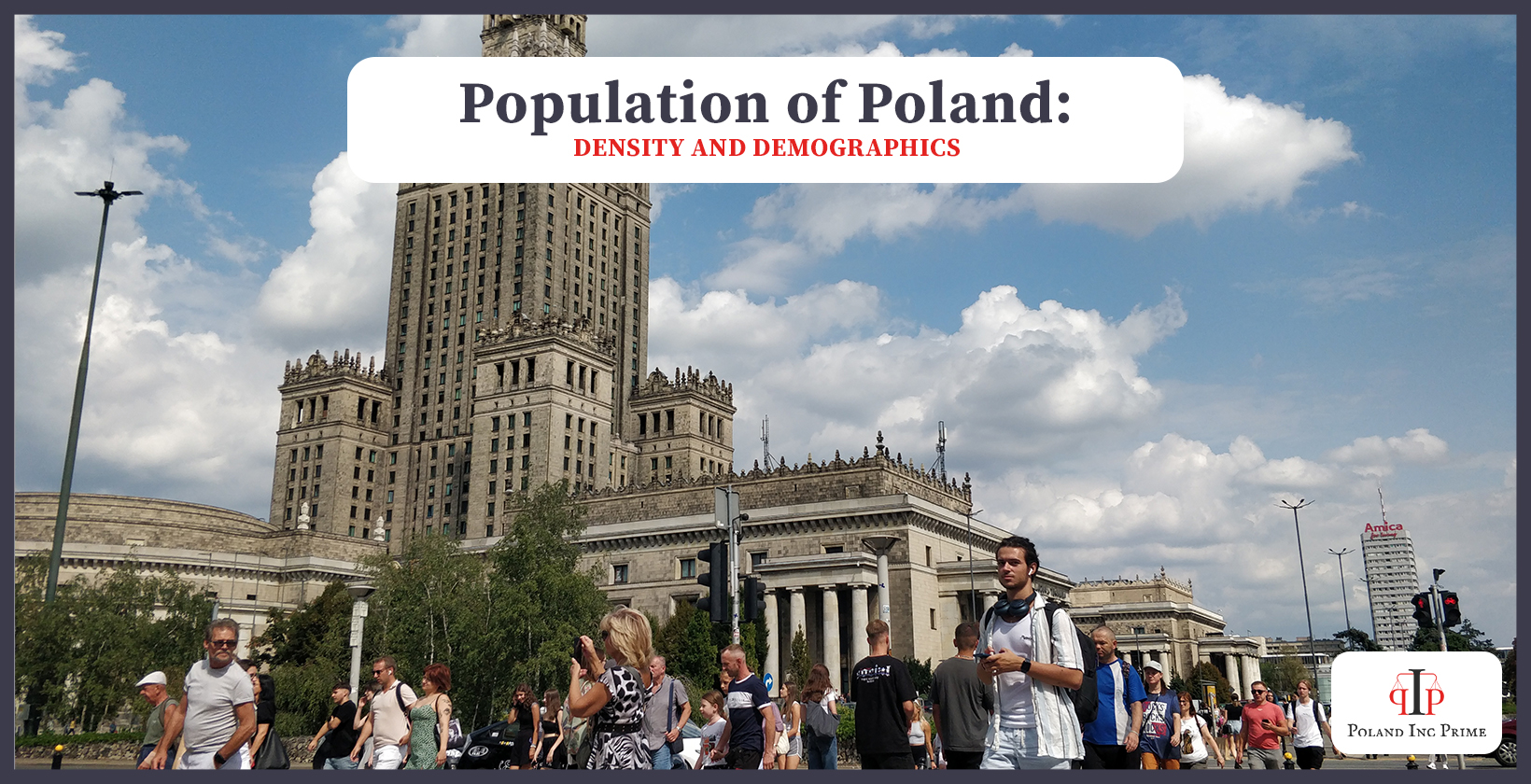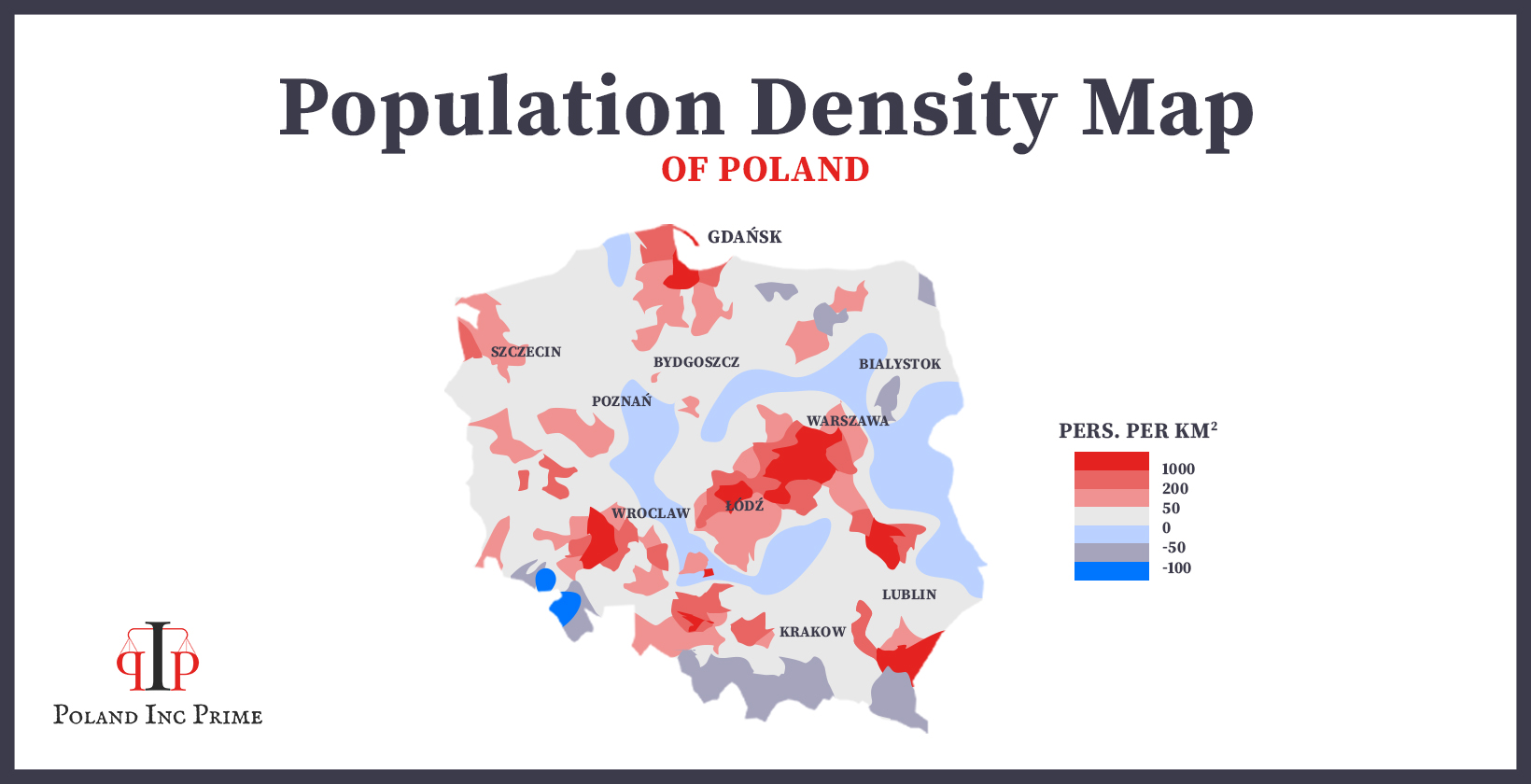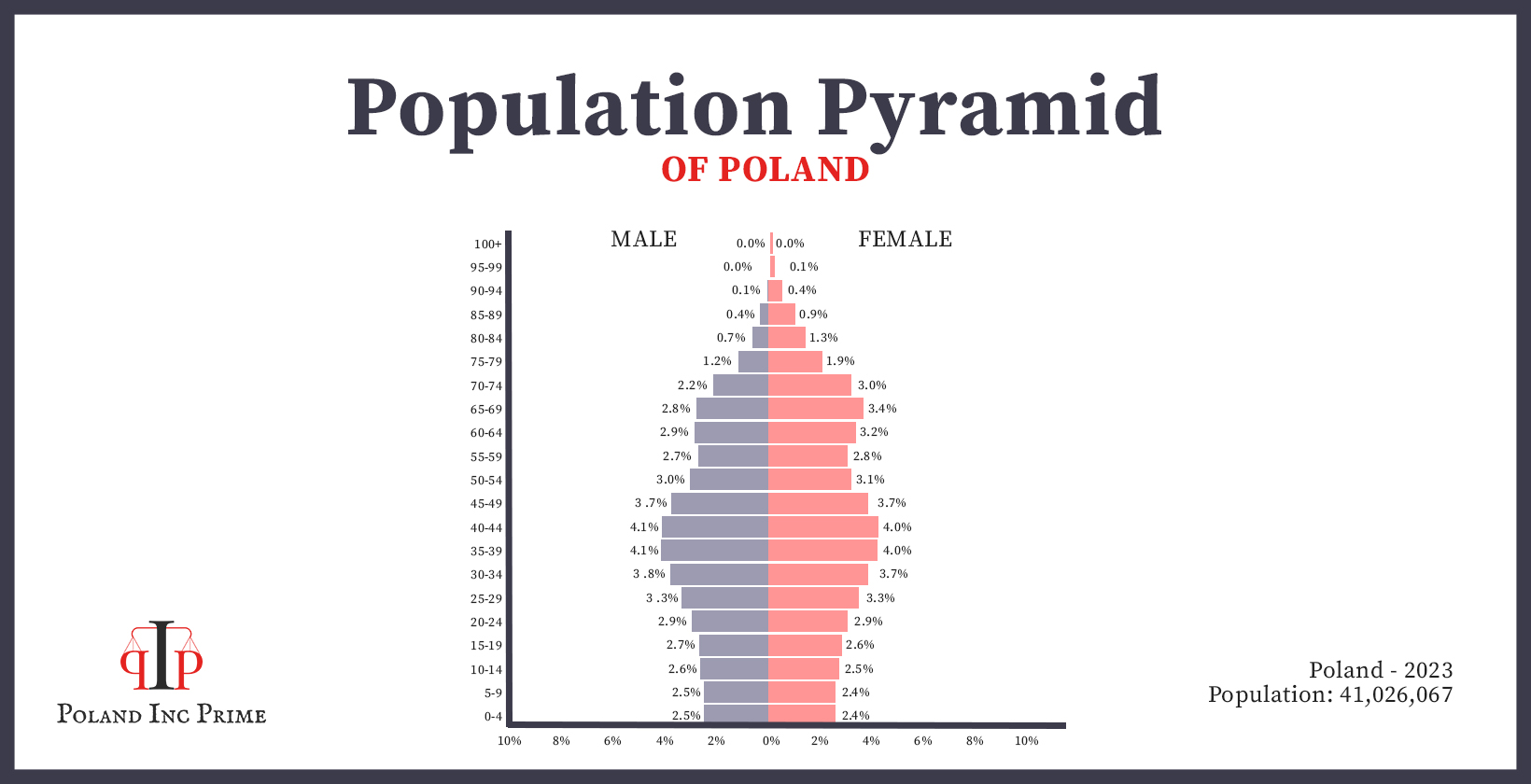
Population of Poland: Density and Demographics
Population refers to the total number of people living in a specific region at a given time. In the case of Poland, the current population is 40,909,859 based on projections of the latest United Nations data.
Knowing the growth rate of a country’s population is crucial for understanding its dynamics. Poland has been experiencing a relatively stable growth rate, with a slight increase over the years. At that time, the annual growth rate is estimated to be around 0.1%, primarily due to factors like births and immigration.
Warsaw, the capital city, is a major focal point of Poland’s population, with over 1.7 million residents. Additionally, cities like Krakow, Wroclaw, and Poznan play significant roles in shaping the country’s demographics. Poland is a diverse nation, with various ethnicities contributing to its rich tapestry. The majority of the population identifies as Polish, but there are also smaller communities of Ukrainians, Germans, and Belarusians, among others.
When knowing the average age of the population, it’s worth noting that Poland has a relatively aging population. The average age is around 40 years, indicating a gradual shift towards an older demographic. In terms of gender ratio, there is a slightly higher number of females than males in Poland, with women making up approximately 51% of the population.
Poland has a vibrant entrepreneurial spirit, with a growing number of business owners and entrepreneurs. This trend has been on the rise in recent years, reflecting a dynamic and evolving economy.
Table of Contents
What is the Population of Warsaw?
The population of Warsaw, the capital city of Poland, is slightly over 1.7 million residents. Warsaw is the largest city in the country and serves as its political, economic, and cultural hub. Other major cities in Poland, such as Krakow, Wroclaw, and Poznan, also contribute significantly to the country’s population and play essential roles in shaping its demographics and regional dynamics. The closest city to Warsaw in terms of population count is Łódż with almost 0.8 million residents then comes Kraków in the third place with 0.75 million residents.
Which Cities in Poland are the Most Populated?
The most populated cities in Poland are Warsaw with 1.7 M followed by Lodz, Krakow, Wroclaw, Poznan then Gdansk, as mentioned in the table below showing each top city and its population count sorted descending.
| City Name | Population |
| Warsaw | 1,702,139 |
| Lodz | 768,755 |
| Krakow | 755,050 |
| Wroclaw | 634,893 |
| Poznan | 570,352 |
| Gdansk | 461,865 |
| Szczecin | 407,811 |
| Bydgoszcz | 366,452 |
| Lublin | 360,044 |
| Katowice | 317,316 |

Poland is known for its various ethnicities and cultural diversity. The most common ethnicities are Ukrainians and Belarusians following the Polish. The ethnicities in the most populated cities in Poland are shown as below:
- Warsaw: As the capital and most populous city, Warsaw is a melting pot of cultures and ethnicities. The majority of the population is of Polish ethnicity, but there is also significant communities of Ukrainians, Belarusians, and people from other Eastern European countries due to historical migration patterns and urbanization.
- Lodz: Lodz is one of Poland’s most populated cities, and like many others, it reflects the nation’s diverse cultural fabric. The majority of Lodz’s population is of Polish ethnicity. However, Lodz has a unique history of cultural and industrial diversity, which has left an imprint on its demographics.
- Krakow: Krakow has a predominantly Polish population, but it’s also a popular destination for international tourists and students. This diversity introduces various ethnic backgrounds to the city’s cultural fabric.
- Wroclaw: Wroclaw’s population is primarily Polish, but it has historical ties to German culture due to its past as part of the German Empire. Today, there are still some residents with German heritage.
- Poznan: Like many other Polish cities, Poznan has a predominantly Polish population. However, it also has a history of German influence, and there are residents with German roots.
- Gdansk: Gdansk, located on the Baltic Sea, has a diverse population influenced by its maritime history. In addition to Poles, you’ll find a mix of nationalities, including Kashubians, Germans, and other Baltic Sea region communities.
- Szczecin: Szczecin, another city on the Baltic coast, has a predominantly Polish population, but it has historical links to German culture, and some residents may have German ancestry.
- Bydgoszcz: Bydgoszcz’s population is primarily Polish, but it’s known for its cultural diversity due to its history as a trade and manufacturing hub.
- Lublin: Lublin is a city with a rich history, and while the majority of its population is Polish, it has been influenced by various cultures over the centuries, including Jewish, Ukrainian, and Belarusian communities.
- Katowice: Katowice, in the industrial heartland of Poland, has a primarily Polish population, but it has seen migration from other regions within Poland for work opportunities.
What are the most common ethnicities in Poland?
The most common ethnicities in Poland are:
- Polish: The vast majority of Poland’s population identifies as ethnically Polish. This group forms the dominant ethnic majority and has a significant influence on the country’s culture, language, and traditions.
- Jewish: Historically, Poland had a substantial Jewish population. However, due emigration, the Jewish community in Poland is now much smaller. There are efforts to revive Jewish culture and heritage in the country.
- Black: Poland is not known for having a significant indigenous Black population. However, in recent years, the country has seen an increase in the number of Black immigrants and students, particularly in larger cities, contributing to a more diverse cultural landscape.
- Muslim: Poland has a small but growing Muslim community, primarily made up of immigrants and their descendants from countries with significant Muslim populations. Major cities like Warsaw, Krakow, and Wroclaw have mosques and Islamic centers to serve the needs of this community.
It’s important to note that while Poland’s population is predominantly ethnically Polish, the country is becoming more diverse due to immigration and globalization, leading to a richer tapestry of cultures and ethnicities. The numbers and demographics of these groups may vary over time.
What is the Population of Jewish People in Poland?
The population of Jewish people in Poland is estimated to be around 10,000 to 20,000 individuals. This represents a very small percentage of Poland’s overall population, approximately 0.03% to 0.05%.
What is the Population of Black People in Poland?
Poland has a relatively small population of Black people, estimated to be around 30,000 to 40,000 individuals. This represents approximately 0.08% to 0.11% of Poland’s overall population.
What is the Population of Muslim People in Poland?
Poland has a small Muslim population, estimated to be around 20,000 to 40,000 individuals. This represents approximately 0.05% to 0.10% of Poland’s overall population.
What is the Average Age of People in Poland?
The average age in Poland is approximately 40 years, which is a significant indicator of the country’s demographic profile. This average age reflects a slightly aging population trend.
Regarding religious population, Poland is predominantly Roman Catholic, with the Catholic Church playing a significant role in the country’s culture and traditions. However, Poland is also home to various religious minorities, including Orthodox Christians, Protestant denominations, and a growing Muslim community, as mentioned earlier. These diverse religious groups contribute to Poland’s multicultural landscape.
What is the Population of Religious People in Poland?
Poland has a predominantly Catholic population. Here’s a breakdown of the religious demographics in Poland:
- Catholicism: Catholicism is the dominant religion in Poland, and the majority of the population identifies as Roman Catholic. Approximately 32 million people in Poland, or about 85% of the population, adhere to Catholicism.
Among Catholic practitioners, there is a mix of age groups, with a significant number of both young and older adherents. The Catholic Church has a strong influence on various aspects of Polish life, including culture and traditions.
- Orthodox Christianity: Poland is also home to a smaller Orthodox Christian community, primarily among ethnic groups such as Ukrainians and Belarusians. The Orthodox Christian population is estimated to be around 500,000 to 1 million people, constituting approximately 1% to 2% of the population.
Orthodox Christians in Poland are often concentrated in regions with historical ties to Eastern Orthodoxy, such as Podlaskie Voivodeship.
- Protestant Denominations: Poland has a relatively small but diverse Protestant community, including various denominations such as Lutherans, Baptists, and Pentecostals. The Protestant population is estimated to be around 100,000 to 200,000 people, making up about 0.3% to 0.5% of the population.
Protestant adherents in Poland are found in various regions, with congregations in Warsaw and Wroclaw.
- Islam: Poland’s Muslim population is small but growing due to immigration. As of 2021, there were approximately 20,000 to 40,000 Muslims in Poland, representing about 0.05% to 0.10% of the population.
The Muslim community in Poland is diverse and includes both long-standing residents and recent immigrants, with mosques and Islamic centers in Warsaw and Krakow.
In terms of gender distribution, religious adherence is not significantly gender-biased in Poland, and both men and women participate in religious activities. However, the level of religiosity may vary among individuals regardless of gender.
What is the Gender Ratio in Poland?
In Poland women slightly outnumber men, with females making up approximately 51% of the population, while males account for about 49%. The gender ratio in Poland is relatively balanced.

In terms of entrepreneurship and business ownership in Poland, the country has seen a growing number of women entrepreneurs in various sectors. There are an estimated 1.3 million women-owned businesses in Poland, contributing significantly to the country’s economic growth. This trend reflects a more inclusive and diverse business landscape, with women entrepreneurs playing a vital role in various sectors of the Polish economy.
What Percentage of Polish Population Owns a Business?
Approximately 16% of the Polish population is estimated to own a business or be involved in entrepreneurial activities in some capacity. This represents a significant portion of the population engaged in various aspects of the economy in Poland, from small businesses to startups and self-employment.
It’s important to note that entrepreneurship has been on the rise in Poland, with various government initiatives and programs aimed at fostering a conducive environment for business development. The country has seen a growing number of small and medium-sized enterprises (SMEs), which play a vital role in the Polish economy.
In addition to Polish entrepreneurs, Poland has also attracted foreign investors and entrepreneurs who have contributed to the country’s economic growth and diversity. Foreign-owned businesses and investments have become increasingly common in Poland, further enriching the nation’s business landscape, and fostering economic ties with other countries.
What Percentage of Foreigners Own a Business in Poland?
It is estimated that foreigners owning or starting a business in Poland represented approximately 7% of all registered businesses in the country. This percentage indicates a notable presence of foreign entrepreneurs and investors in the Polish business landscape.
Starting a business as a foreigner in Poland involves navigating various legal and administrative procedures, but the country has made efforts to simplify these processes and attract foreign investment. Many foreigners have chosen Poland as a destination for business opportunities, particularly in sectors such as technology, manufacturing, and services.